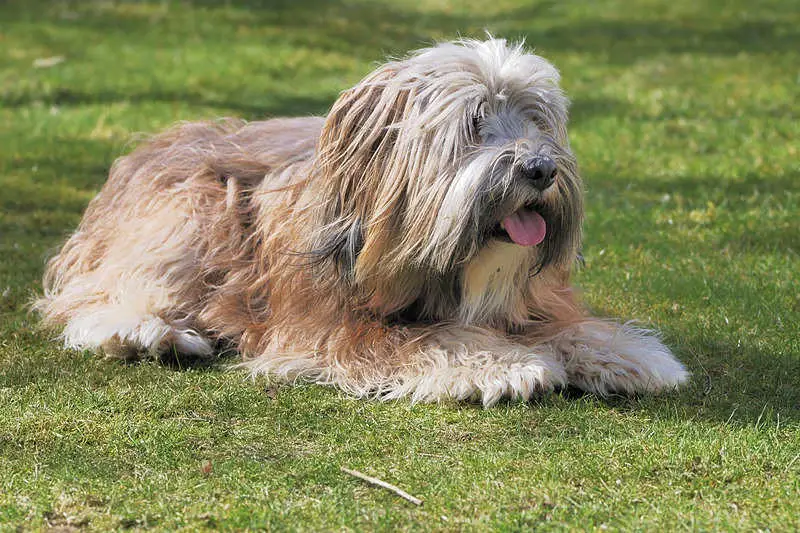The solid, luxuriously coated Tibetan Terrier boasts a thousand-plus years of pedigree, and as an owner you can catch endearing glimpses of its historical role as a sentry and companion dog of Buddhist monasteries. This “Holy Dog of Tibet” – a bit of a lookalike of its smaller counterpart, the Lhasa Apso – makes a wonderful home or apartment buddy, and you can pretty much be guaranteed some admiring glances cast to the end of your leash during the daily walk.

The Tibetan Terrier dog breed
Let’s make something clear right from the start: The Tibetan Terrier is not a true terrier, a category that refers to small dogs bred to hunt vermin. Westerners traveling in Tibet mistakenly applied the “terrier” tag to the Holy Dog of Tibet on account of its size and general appearance.
History
The Tibetan Terrier was bred as a multipurpose dog in the high, harsh climes of the Tibetan Plateau and adjacent Himalaya. In addition to patrolling monasteries and keeping Tibetan lamas company, these strong and nimble dogs – possessed of broad, furred, snowshoe-like paws ideal for navigating the high-elevation terrain – also served as livestock herders. According to Juliette Cunliffe’s Tibetan Terrier, Tibetan Terriers “were also reputed to be so agile that they were of great assistance in retrieving objects that had fallen into some inaccessible place” along the herding routes.
Cunliffe notes the likely shared ancestry of Tibetan Terriers and such roughly similar Eurasian working dogs as the Hungarian Puli, the Pumi, and the Polish Lowland Sheepdog. As noted above, the breed also looks quite a bit like a slightly larger Lhasa Apso, and there’s some muddled middle ground between the two Tibetan dogs; the Apso name in Tibetan refers to the shaggy look, and in its homeland both Tsang Apso and Dokhi Apso have been applied to the Tibetan Terrier.
As both the American Kennel Club and Tibetan Terrier Club of America explain, Tibetan Terriers – also sometimes called “Little People” in their native digs – were cherished and gifted as bringers of good fortune.
The Tibetan Terrier began to gain wider renown in the 1920s and ’30s in British India – the Indian Kennel Club established a breed standard for the dog in 1930 – and Europe. The mid-1950s saw its appearance in the United States, and the American Kennel Club recognized it in 1973. During the latter half of the 20th century, the Tibetan Terrier showed up increasingly in the show ring. These days, there are Tibetan Terrier clubs all over the globe, and every other year a different country hosts the Tibetan Terrier World Congress.
Appearance
The Tibetan Terrier is a medium-sized dog, standing some 14 to 17 inches at the shoulder and weighing between 18 and 30 pounds.
Its most prominent characteristic is its rich, weatherproof double coat, which in its homeland protects the Tibetan Terrier from the elements. The topcoat is long and shaggy, though unlike the Lhasa Apso’s this outer fur doesn’t hang to the ground in the breed standard. The Tibetan Terrier’s charming face gets much of its character from the luxuriantly long eyebrows that drape over the eyes–such a natural fall provided good protection on the Tibetan Plateau from blazing high-altitude sunshine and snow as well as windblown dust–and from the dignified and similarly regal beard.
The Tibetan Terrier is square and solid-looking with those big, broad, snowshoe paws and a high-standing tail curved over the back (as in other Tibetan dog breeds).
Tibetan Terriers come in a wide range of colors, from black to white and just about everything in between.
Personality and temperament
The Tibetan Terrier is a friendly and loyal dog that can get along quite well with children, especially older ones who practice good manners around it. As befits this born-and-bred watchdog, the breed is suspicious of strangers (but shouldn’t be aggressive toward them).
Their size, disposition, and exercise needs mean the Tibetan Terrier is a good fit for apartment/city living. As the American Kennel Club notes, many a Holy Dog of Tibet likes to claim a spot in the home with a good view for surveying proceedings–thus fulfilling their old-school role as a watchdog of the Buddhist monasteries of home.

Shedding and grooming
While the Tibetan Terrier doesn’t shed particularly much, its shaggy uniform does require a fair bit of grooming: for the pet dog, brushing of several times a week or perhaps trimming to ward against the formation of mats. Brushing can be a great opportunity to bond with your dog, and at its best is a relaxing, enjoyable activity for the both of you.
Health and lifespan
Among the health issues to watch for with the Tibetan Terrier are primary lens luxation, progressive retinal atrophy, canine neuronal ceroid lipofuscinosis, and canine hip dysplasia. Older Tibetan Terriers may develop cataracts, heart murmurs, and other issues, but an otherwise healthy dog typically lives 15 to 16 years (or even a bit more).
Exercise needs
Tibetan Terriers have moderate exercise needs that can be satisfied with daily walks and other physical activity. The American Kennel Club suggests consulting with a breeder to match yourself with a Tibetan of relatively more or less energy levels depending on your own. These dogs also excel at lounging about, though always with a watchful eye out.
Training
Tibetan Terriers are smart and fast learners, but easily bored by repetitive training methods and potentially stubborn in the face of inconsistent ones. Keep training creative, firm, and defined by positive reinforcement, and you’ll likely shape a very winning personality in your “Little Person.”
